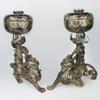Impressionist and Modern Paintings Highlighted On The Curator’s Eye
- BOSTON, Massachusetts
- /
- November 06, 2013
BOSTON - “With all eyes on the multimillion-dollar paintings, drawings and sculptures being sold at the Impressionist, modern and contemporary art auctions that begin in New York next week,” as New York Times columnist Carol Vogel writes, The Curator’s Eye (www.CuratorsEye.com) highlights a number of offerings of Impressionist and modern art presented on the online exhibition by leading private dealers from around the world.
Marc Chagall - Drawings for the Bible
The selection of Impressionist and modern works begins with the first American edition of Marc Chagall’s second series of illustrations for the Bible from 1960. This breathtaking blend of Chagall’s childhood experience of the world of the Hebrew Bible was a massive undertaking that occupied Chagall off and on from 1931 to 1956, and again between 1958-59. The printer Fernand Mourlot ran a lithography press where such greats as Braque, Matisse, Picasso, Miró and, of course, Chagall came to have their designs printed and to learn about this still nascent medium.
Max Pechstein - Fishing Boats in the Afternoon Sun (Recently Sold)
As an artist labeled “degenerate” in 1937 by the Nazis, German artist Max Pechstein has been in the news lately. However, hailed in the 1920s by German critics as the "Giotto of his time," Hermann Max Pechstein was considered to be the major talent of German Expressionism. The loss of much of Pechstein's work during the war makes the few existing pieces by his hand incredibly rare and highly sought after.
As a perfect example of his exceptional abilities, Fishing Boats in the Afternoon Sun depicts a vibrant harbor scene in the Eastern Pomerian town of Leba. This waterscape, which recently found a buyer, depicts sailboats on the banks of the Lebasee juxtaposed against a striking blue sky. Pechstein's vitality of brushstroke and the intensity of the exaggerated color meet a brutality of form and distorted shape that create an explosion of emotion on the canvas.
William Howe - Lanscape at Auvers
This work, Landscape at Auvers, was painted in 1890 by William H. Howe. Auvers-sur-Oise was an artist colony north of Paris, associated with Van Gogh, Pissarro, Cezanne, Daubigny, and Corot. Howe paints a tranquil landscape of a country road cutting through tall grasses, winding past a haystack and thatched-roof barn. The artist, who studied at the Royal Academy in Düsseldorf, is known for adapting the traditions of Dutch pastoral art with Barbizon-influenced realism and was one of the founders of the art colony in Old Lyme, Connecticut.
Ferdinand du Puigaudeau - Tamaris et Champs de Coquelicots
An oil painting by French artist Ferdinand du Puigaudeau titled Tamaris et Champs de Coquelicots, painted circa 1915, is slated to be included in volume two of the catalogue raisonné in preparation by M. Antoine Laurentin. Puigaudeau’s distinctive impressionistic style is evident in his variations of color and depictions of light. Throughout his career, Puigaudeau maintained a systematic search for vivid, luminous color. Following this interest, he chose subjects that would allow him to play with the extremes of color and light. Puigaudeau claimed to believe in “color above all else,” and his scenes sparkle with vivid shades of blue, green, gold, and red.
Eugene Boudin - Village aux Environs de Dunkerque
Also available is a signed oil painting by Eugène Boudin, Village aux Environs de Dunkerque, whose plein air works depicting land and seascapes had a great influence on the emerging Impressionism. Boudin, who late in life successfully exhibited at the Paris Salon and through the famous Durand-Ruel Gallery, spent his childhood along the coasts of Normandy where he later sold works. Boudin’s finished pieces show the beginning of a freeness in overall execution bordering on a sketch-like rendering, but Boudin’s method, while en plein air, was nevertheless meticulous in its arrangement. By the end of his career, Boudin was regarded as the premier marine painter whose popularity continued to grow after his death in 1898.
Maurice de Vlaminck - Femme a la Ferme
Another available work is Femme a la Ferme, by French artist Maurice de Vlaminck, whose career spanned the decades and numerous artistic movements and styles. As one of the most important Fauve artists, a short-lived but nonetheless, significant artistic movement that opened the early twentieth century, Vlaminck freed himself from conventional ideals. Extending the innovations of post-impressionists, Vlaminck and Fauvism introducing a new color palette unlike anything seen before. While the artist’s career continued through Salons and the dealer Ambroise Vollard, he never lost his initial respect for and interest in the natural landscape. Late in his career, as Vlaminck continued painting, his palette began to darken and his execution relied more on a naturalistic rendering of nature, one that may appear somewhat foreboding in its character.
Diego Rivera - Iglesia de Lequeitio; Antonio Rodriguez Luna - La Intriga
Two works by artists of Spanish and Mexican heritage also join the offering from The Curator’s Eye. Iglesia de Lequeitio by Diego Rivera, a tempera and pastel drawing from 1907, has been considered a masterpiece of Rivera's early work by Berta Taracena, noted art critic and scholar. This signed work comes to the market from Angelina Beloff, wife of the artist.
Additionally, the oil painting La Intriga by Antonio Rodríguez Luna, one of the founders of the Salón de los Independientes, is typical of the artist’s iconic melancholy, abstract style. Luna was from Cordoba, Spain, lived in Madrid and moved to Mexico after the Spanish Civil War. While there, he taught at Escuela Nacional de Artes Plásticas.
John Traynor - Rockport, MA, in Winter; Evan Wilson - The Cerulean Sash
In the oil painting by John Traynor titled Rockport, MA, in Winter, painted in 2012, the artist uses color and brushstroke to capture the essence of nature, light and emotion in a way few other artists can achieve. Indeed, his impressionistic style allows the viewer to enter the scene he has set, and create a story within the frame to make it more personal. A further contemporary piece that pays its debt to the Old World traditions is Evan Wilson’s 2013 oil on canvas The Cerulean Sash. His painting style acknowledges the past while capturing the present. Wilson demonstrates an exquisite paint-handling ability; his rich color palette and talent for capturing light unite to striking effect. He has been praised for his masterful control of light and shadow, beautifully depicting their effects on figures and objects.
The Curator’s Eye is the distinctive online platform for the finest art and antiques from distinguished dealers around the world. To view more exceptional Impressionist and Modern items, visit www.CuratorsEye.com.
Contact:
Leah TharpeThe Curator's Eye, LLC
8885995099
leah.tharpe@curatorseye.com
CuratorsEye@gmail.com
888-599-5099
http://www.curatorseye.com
About The Curator's Eye, LLC
A scholarly online exhibition connecting museums, collectors, and dealers with the finest art and antiques available on the market.



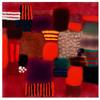
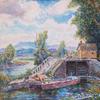
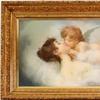


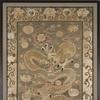



![Offering a Truce [Bested], 1895, is estimated to sell for between $1,300,000 and $1,800,000 on March 22, 2014, for The Russell: An Exhibition and Sale to Benefit the C.M. Russell Museum. Offering a Truce [Bested], 1895, is estimated to sell for between $1,300,000 and $1,800,000 on March 22, 2014, for The Russell: An Exhibition and Sale to Benefit the C.M. Russell Museum.](/images/c/a8/20/Dec10_Offering_a_Truce__Bested_300dpi100x100_c.jpg)

